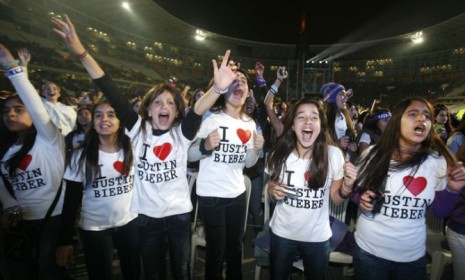Why Bieber Fever is more contagious than the measles
Scientists examine the infectious appeal of 18-year-old megastar Justin Bieber, and why a neverending stream of young girls contract a sick love for him

A pair of researchers from the University of Ottawa used mathematical modeling to answer one of the more pressing questions of our time: Why is Bieber Fever so contagious? Specifically, what is it about Justin Bieber, the teen sensation responsible for chart-topping singles like "Baby" and "Boyfriend," that turns otherwise well-balanced tween girls into clamorous superfans? Here, a brief guide to the strange experiment:
Dare I ask: What is Bieber Fever?
Symptoms include "uncontrollable crying and/or screaming, excessive purchasing of memorabilia... and making poor life choices," like copying the Biebs' signature hairdo, says Rachel Phan at Canada's National Post. And while the teen heartthrob's affect on young girls is obviously "not a formal disease," it has "the hallmarks of a disease," says one researcher. "And so it behaves the way a disease would."
The Week
Escape your echo chamber. Get the facts behind the news, plus analysis from multiple perspectives.

Sign up for The Week's Free Newsletters
From our morning news briefing to a weekly Good News Newsletter, get the best of The Week delivered directly to your inbox.
From our morning news briefing to a weekly Good News Newsletter, get the best of The Week delivered directly to your inbox.
How did researchers study Bieber Fever?
The team used a hypothetical population of 2,000 people and employed a mathematical model used to track fast-spreading disease. The model divides people into three categories: Susceptible, infected, and recovered, says Brian Fung at The Atlantic. And "Bieber Fever is especially nasty" — infecting youngsters at a faster rate than the measles. The infected can recover — "through eventual boredom" or exposure to negative Bieber-related press.
What's the key driver of Bieber fever?
Slow-burning media coverage is among the biggest infectors. And while a "blast of positive news" can infect the suspectible (or re-infect the recovered), it's often "followed by a negative report" that helps some infected Beliebers recover, says Fung. But negative press has an unintentional side effect: "Mobilizing Bieber supporters" on Twitter, who leap to action, thus raising "the likelihood of their transmitting the disease to others." In this way, Bieber Fever has strange ability "to infect and re-infect a generation of children," says Phan — "and it won't stop anytime soon."
A free daily email with the biggest news stories of the day – and the best features from TheWeek.com
Who's behind this study?
The model was put together by University of Ottawa masters student Valerie Tweedle and one of her professors, who generated international headlines in 2008, when he developed a mathematical model for surviving a zombie attack. This particular study on the Bieber-fication of youth culture will be part of a chapter in an upcoming book, Understanding the Dynamics of Emerging and Re-emerging Infections Diseases Using Mathematical Models.
Sources: CBC News, The Atlantic, National Post, Wired
-
 The small Caribbean island courting crypto billions
The small Caribbean island courting crypto billionsUnder the Radar Crypto mogul Olivier Janssens plans to create a libertarian utopia on Nevis
-
 Political cartoons for December 21
Political cartoons for December 21Cartoons Sunday’s political cartoons include Christmas movies, AI sermons, and more
-
 A luxury walking tour in Western Australia
A luxury walking tour in Western AustraliaThe Week Recommends Walk through an ‘ancient forest’ and listen to the ‘gentle hushing’ of the upper canopy